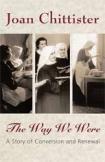Through Open Doors
It is difficult, if not impossible, to overstate the dramatic changes in American religious life in the mid- to late 20th century. Regardless of whether one views them a success or failure, no one can argue that Catholic religious sisters burst through the Second Vatican Council’s doors and windows faster and more enthusiastically than any other group in the American church. To analyze the experience of renewal for American nuns, Sister Joan Chittister, a prolific writer, thinker, interpreter and sometimes critic of the church, trains her astute lens on her own Benedictine congregation in Erie, Pa., between 1960 and 1990.
Focusing on three decades, three congregational administrations and three different leadership styles and tasks, she takes the reader inside the community to experience the difficult and multifaceted transition process toward renewal. Chittister writes: It did not feel like renewal’ then. It felt like disaster, like loss, like liberation, like life gone wild. And it felt like all of them all at once. The Way We Were comes at an auspicious time, as the Benedictine Sisters of Erie celebrate 150 years of their American foundation and 15 centuries of Benedictine religious life.
After the early, heady days of the great missionary endeavors that characterized many 19th-century American religious orders, the passion of its early pioneers...the stuff of vision and dreams had given way to the kind of professional satisfaction that comes with success. By the mid-20th century, custom books prescribed every item of behavior, dictating almost every aspect of religious life for women. Minutely defined schedules controlled every minute of every day.... There were few exceptions, few alterations, almost never a change. It is this moment in time that, according to Chittister, science and religion crossed paths creating a paradigm shift,’ a way of seeing the world differently than we had ever seen it before. Society called it New Science (e.g., quantum physics and chaos theory); in the church, we called it Vatican II. Chittister believes that the real questions were not institutional ones; the real questions were spiritual ones. With this as her premise, the author deftly traces her community’s journey through change, conversion and renewal. She writes, some time between 1960 and 1990 the Benedictine Sisters of Erie, as the city had known them for over a hundred years, disappeared and then, just as suddenly, re-emerged in ways the city never expected.
Chittister frames her story around three different leaders and their administrations, wisely keeping the focus on the community and the requisite skills each prioress demonstrated at a given point in time during the renewal process. This avoids simplistic judgments about good or bad leaders and rightly keeps the spotlight on the community’s transitions during this difficult, ongoing process. Consequently, the stylistic shift from authoritarian to more collaborative leadership can be traced and analyzed.
She begins with the administration of Sister Alice Schierberl, whose leadership began in 1958 and ended in 1964. In Chittister’s view, Schierberl began the deconstruction of pre-Vatican II religious life before the end of Vatican II. Her successor, Sister Mary Margaret Kraus enabled the development of new directions and the testing of new values until her leadership ended in 1978. It was Kraus who was forced to deal with the powerful tensions and upheavals during the time when many communities were coming apart and mass defections threatened to demoralize those who remained, working to recreate new models of individual and community identity. Finally, Chittister takes a look at her own administration, when she took the helm of the Erie Benedictines and moved them into the 1990’s. Moving the group toward new directions without losing the core values of the past, Chittister set out in the midst of the disintegration of past modes of life and ministry to launch a process of revitalization...to become a new kind of presence in the world without abandoning the meaning and bedrock of what had been the very essence of the life for centuries.
This is an engaging and thought-provoking book, written in a manner interesting to the general public as well as women religious. Although the Benedictine Sisters of Erie are a small community compared to many large national and international orders, their story is all the more compelling because it demonstrates the epic transitions experienced by even the smaller religious communities in the United States during and after the Second Vatican Council. The author effectively combines her interdisciplinary academic background in communication theory, social psychology and organizational communication with her vast experience in leadership roles and her current status as a national commentator on American religious life and the American Catholic Church. This provides her with a unique perspective, not only to tell her community’s story of renewal, but to interpret and analyze it within the larger context of the pre- and post-Vatican II church and American culture. In thirty short years, after a lifetime of doing nothing but classroom teaching, the [Benedictines of Erie] had opened soup kitchens, worked in chanceries and ecological projects, developed educational programs for welfare students, gone to foreign missions, opened halfway houses, retreat centers, housing sites for the elderly and even wound up in jail for protesting the Vietnam War.
This is the story of many American sisters and their communitiesa powerful story of personal, spiritual and organizational change that continues to the present. How a long-established lifestyle, dating back 15 centuries, could change in the short span of 30 years is, as Chittister wrote, a question of no small import. As the contemporary American Catholic Church struggles to find its way amid controversy and scandal, this story of one community’s renewal, as well as other renewal narratives written about women’s communities, provides an insightful model of risk, experimentation and revitalization within a tradition-bound, hierarchical church struggling to maintain its relevance in the 21st century.
This article also appeared in print, under the headline “Through Open Doors,” in the November 21, 2005, issue.








